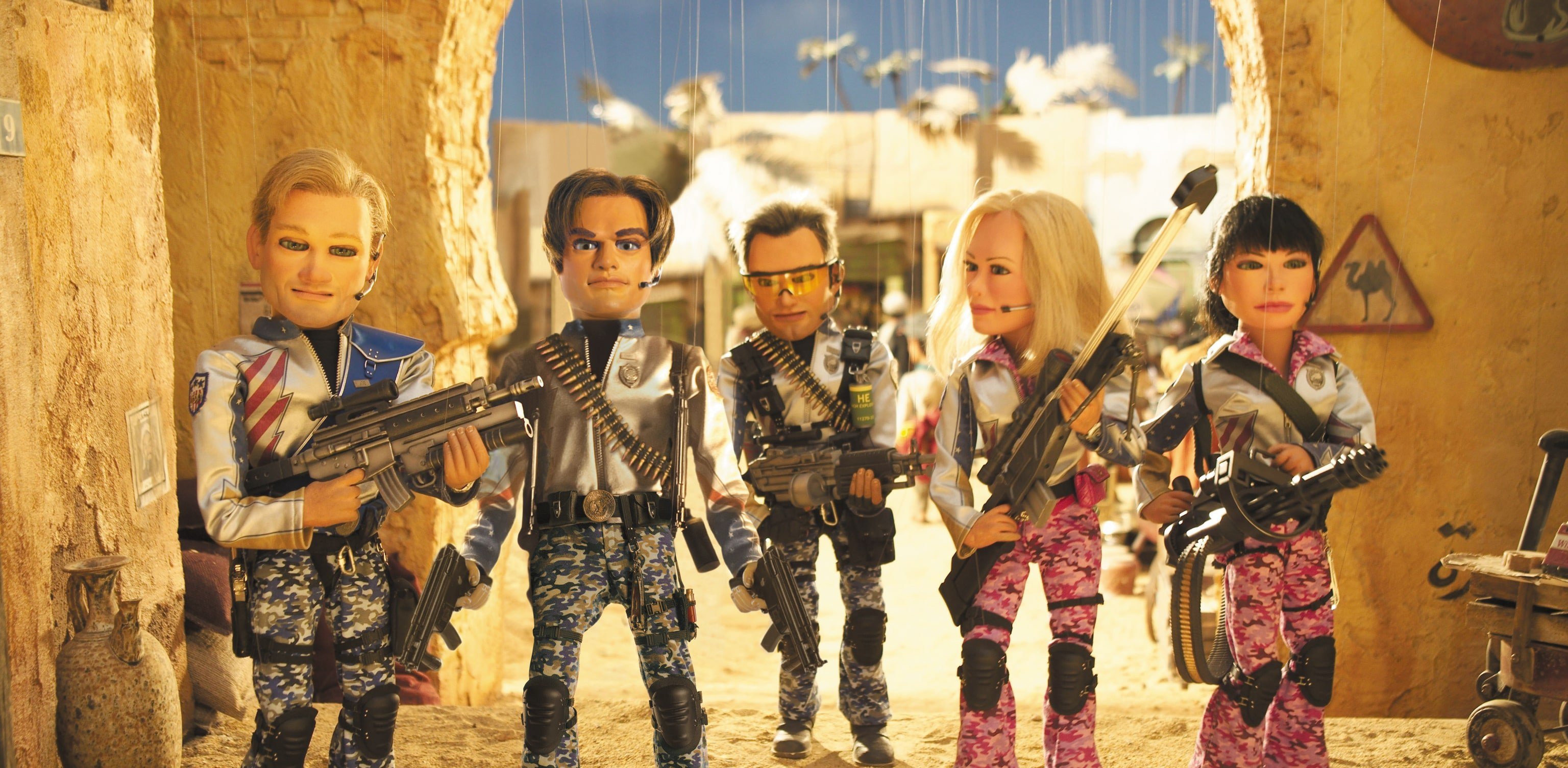
The World on a String — Team America: World Police
Cinematographer Bill Pope is behind the camera for directors Matt Stone and Trey Parker on their marionette action extravaganza.
Unit photography by Melinda Sue Gordon, SMPSP. Photos courtesy of Paramount Pictures.
After serving as director of photography on a series of large-scale, effects-laden action films (The Matrix trilogy and Spider-Man 2), Bill Pope instructed his agents to look for something “completely different.” Little did the cinematographer know that he’d get what he asked for — in spades. “I certainly never saw a puppet movie coming up on my horizon,” Pope says with a chuckle. “However, when [directors] Matt Stone and Trey Parker sent me the script, I literally laughed out loud as I read it. At the time, I didn’t know they wanted to make the film entirely with puppets. When I finally met with Matt and Trey and they told me they wanted to do the whole film with marionettes — all in camera, with no CGI — I told them I was their man. CG allows you to do things onscreen that you shouldn’t be able to, but many times those kinds of effects can take you out of the story. For me, the organic quality of doing things in camera is usually much more charming.”
“Team America was certainly inspired by the work that Gerry Anderson did. He created an entire niche with all of his different marionette shows, the most popular of which was Thunderbirds.”
— director Matt Stone
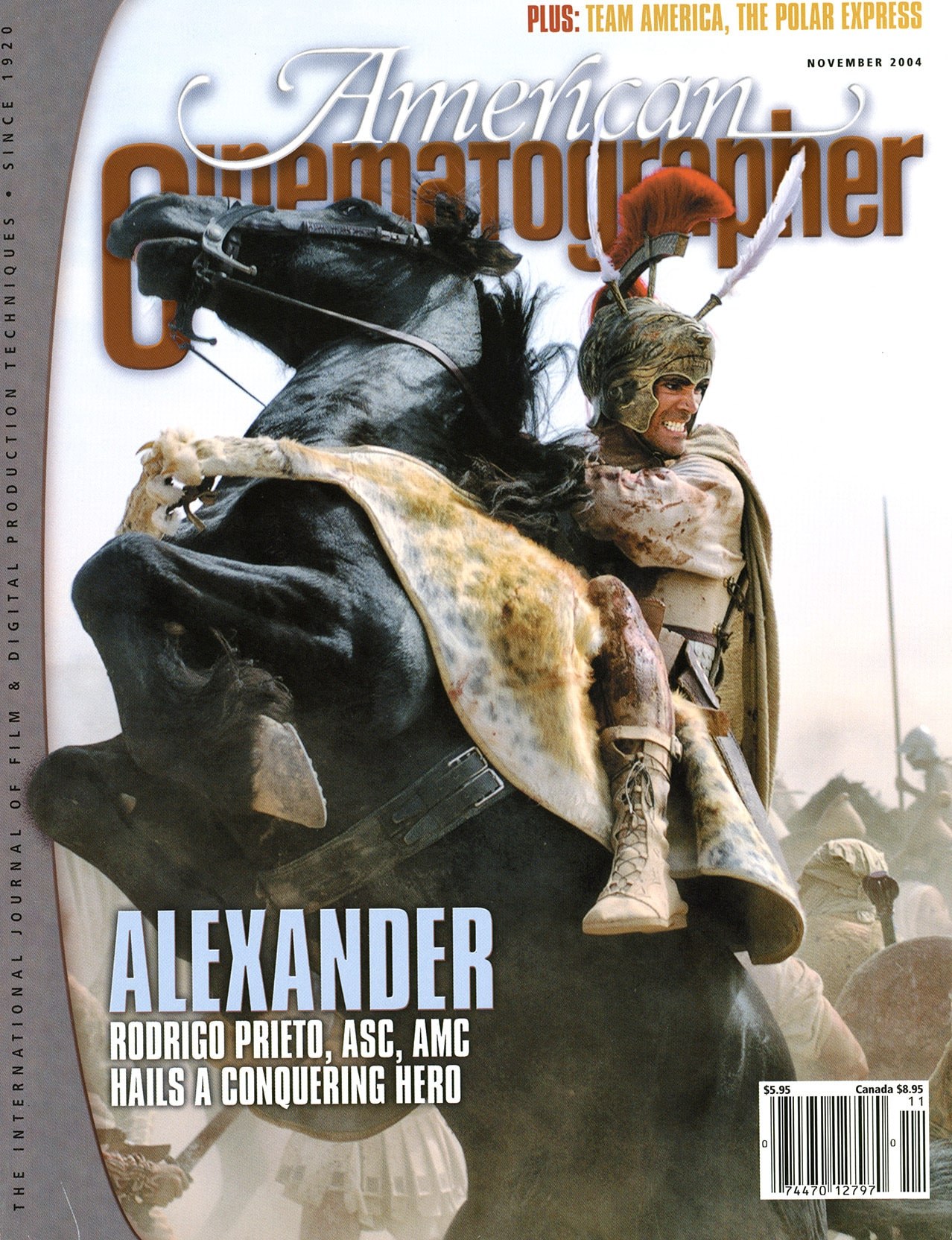
Stone and Parker have earned considerable notoriety for their raw and controversial animated television series South Park. In 1999, the eccentric duo released an even racier feature-film installment: South Park: Bigger, Longer & Uncut. Their other collaborations include the features BASEketball and Orgazmo, as well as the TV series That’s My Bush! “Bill was suggested to us by our producer, Scott Rudin, who had worked with him on Clueless,” says Stone. “From the outset, we felt we should find a cinematographer who had shot these kinds of action movies. In fact, the entire precept of Team America is based on the idea of doing a huge, overwrought, Bruckheimer-esque action/event movie, only with puppets. When we wrote the script, however, we didn’t write it with puppets in mind. We just wrote it like any big action film — a guy jumps his motorcycle over 16 cars and there’s a big explosion — and handled the script without any thoughts about how we would actually do it!”
In true South Park fashion, no individual, religion or political affiliation is safe from being roasted in this election-season satire. To focus their gibes, the filmmakers dreamed up “Team America,” an elite group of world freedom fighters who battle to save democracy against tyrannical oppression and terrorist intimidation. “They’re sort of like the A-Team and James Bond fused together,” notes Pope. “We don’t know if they’re government-sponsored or whatever, but they basically go around solving various problems and fighting terrorism. Of course, they manage to screw things up in as many ways as possible. Along the way, Matt and Trey send up everything and everyone; as in the South Park movie, nobody is safe, and anybody can be made fun of. If you’re going to have satire, you might as well make it all-encompassing.
“What would [Jerry] Bruckheimer do?” This single idea informed many of the film’s camera, lighting and narrative choices.
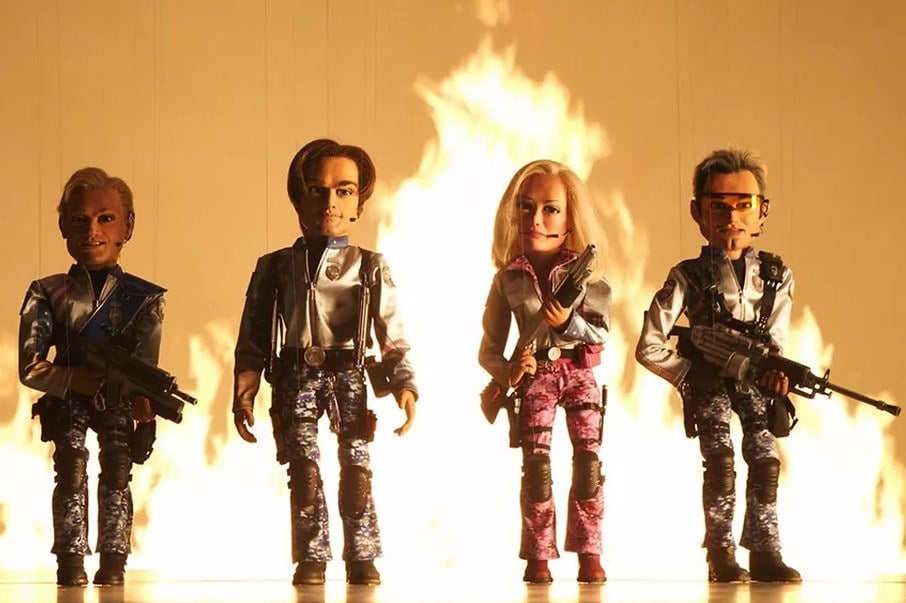
“The conflict of the film,” he continues, “is that [North Korean dictator] Kim Jong Il is trying to take over the world with weapons of mass destruction, and he’s using the Chechens and Al-Qaeda as his pawns. His other ‘lackeys’ are liberal film actors who don’t believe in ever fighting battles and in keeping peace at any cost. So on one hand, Matt and Trey are mocking all of the high-profile, left-wing liberals; on the other hand, they simultaneously make fun of the right-wing American convention of going in and saving the day. In the end, we hope to come down someplace in the middle.”
Stone and Parker took inspiration for the film from the 1960s British marionette series Thunderbirds, created by Gerry Anderson and photographed by John Read. “Team America was certainly inspired by the work that Gerry Anderson did,” Stone explains. “He created an entire niche with all of his different marionette shows, the most popular of which was Thunderbirds. But while those shows gave us some ideas, we were not fans of them at all. In fact, we thought they were pretty boring, which inspired us to parody the shows as well.”
Pope admits he wasn’t a follower of the original puppet series either. “In fact, I had never even seen Thunderbirds,” he confesses. “My generation sort of missed it, and when I did come across it, I was at an age where camp didn’t appeal to me. However, what we learned from those shows was to treat the genre seriously and not make fun of the puppets. We’d just design a scene as you would with any action ‘actor’ and then let the puppets do it. The problem is that marionettes can never quite stand up straight or move gracefully — they’re inherently stupid things, so we didn’t need to enhance that factor. In fact, we tried to downplay it as much as possible.”
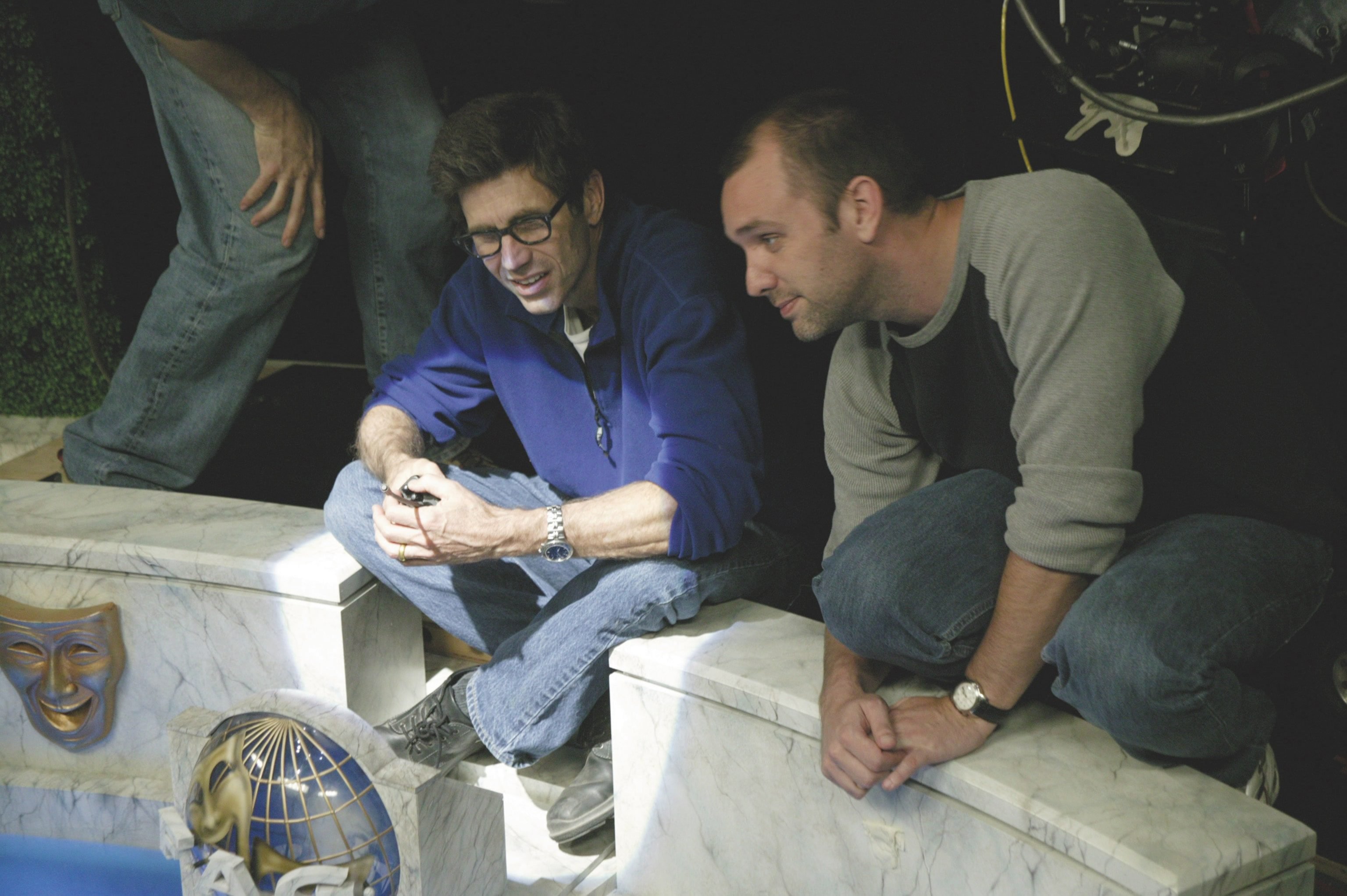
Devising a plan of attack for the low-budgeted shoot demanded considerable R&D. Since the puppets were being created at 1⁄3 scale, all sorts of issues had to be addressed, including set design, dressing and construction, miniature props, the scaling-down of lighting instruments and the use of camera-moving platforms. “Matt and Trey had been working on this in their heads for quite a while before I was hired; they even took some Barbie dolls and a crew out last October to shoot a day of tests, just to find out how hard it was going to be. Of course, they quickly discovered it was quite difficult. Then, after I was hired, the original plan was to shoot for three weeks in the spring and then shut down while they went back to work on South Park; after that, we would start up again for another four weeks in the summer to finish the movie. They figured it would take about seven weeks to shoot the entire film.
“In preparing the film, we started with a small three-day test shoot in February of this year. As we got ready for the tests, we started to realize just how long things were going to take. The variables became more and more solid, and we realized that to control the marionettes, we were going to have to fly eight to 10 puppeteers around the set all the time. To do that, we would have to build bridges above the sets and fly Condors overhead. We also realized we would have to use some rod puppets from underneath; in those instances, holes would have to be drilled and grooves made in the floors on a per-shot basis. Still, even with storyboards, it was difficult to anticipate everything that was needed to execute a particular shot. After just three days of prep, we realized it was going to be even harder and more time-consuming than we thought. Seven weeks was a ridiculously short amount of time in which to do this type of film.”
Shooting the tests shed light on several obstacles that needed to be addressed for the main shoot. “We learned a lot by shooting things on a smaller scale,” Pope reveals. “At 1⁄3 scale, a small bump in the dolly track becomes much larger, like a 6 on the seismic scale. A 2-foot dolly move became the equivalent of a 6-foot move. We also had to figure out how to get the dolly to work at 4 inches off of the ground all the time, and how to make moves that were really tight. Additionally, we had to determine how to get the lighting in close and which depth of field to work at. We looked at shooting at T5.6 or T8 so that the depth of field would look roughly like it would if the puppets were life-sized. We also tried out shallower depths of field, like T4 and T2.8, which made them look more like puppets. When we screened the footage, we all much preferred the fakery of shooting at T4 than at a stop that would give us more depth of field. Shooting at T4 was equivalent to shooting a T2 or less when shooting a 6-foot-tall actor — it created a very shallow depth of field.”
“The puppeteering requirements forced us into a pace that was just glacial. The entire crew ended up doing a lot of crossword puzzles, which were actually printed on the backside of each day’s call sheet.”
— cinematographer Bill Pope
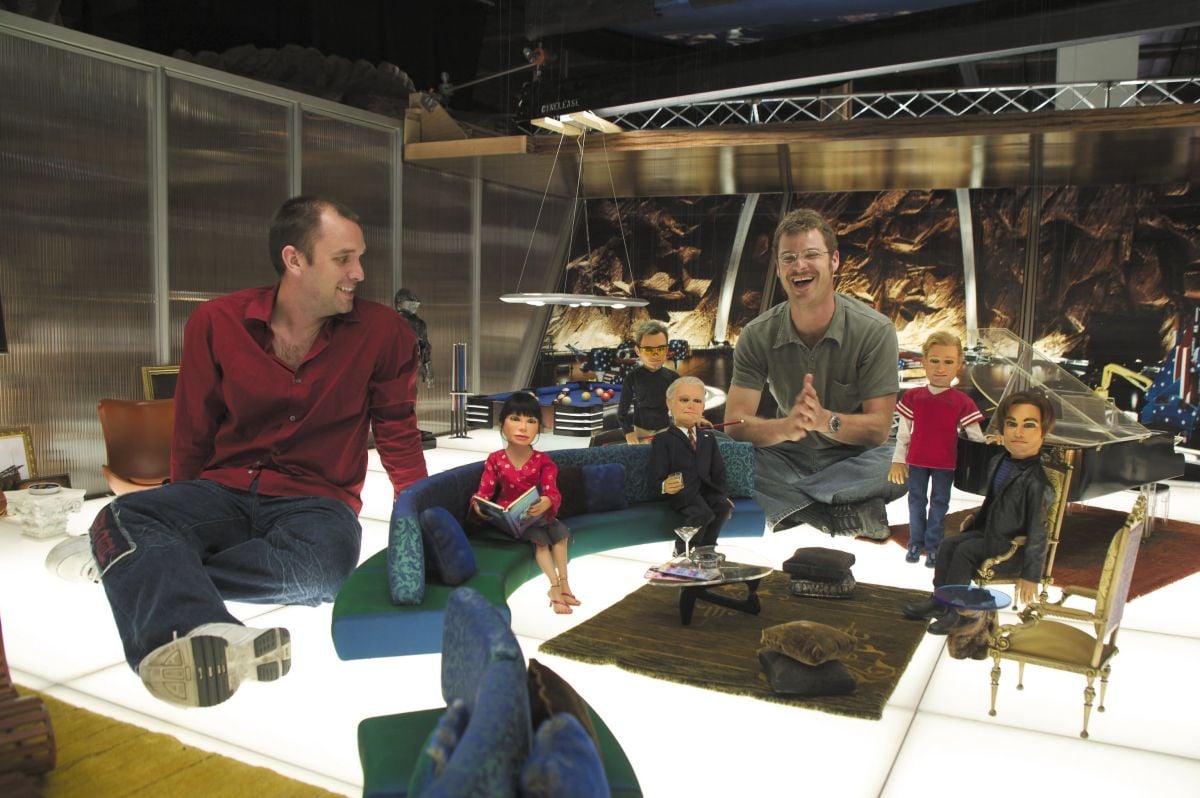
“It was definitely a trial by fire,” confesses Stone. “Trey, Bill and [first AD] Eric Jewett have been really involved with figuring out how to even block this stuff. You can’t just do what will look good; you have to do what will look good and what is practically possible. For example, you can’t have puppeteers cross strings. Also, you can’t do any really low-angle shots, because you would see that there aren’t any ceilings above the marionettes. Likewise, you can’t have any really high-angle shots, because you end up with a bunch of strings in front of the lens. In addition to all of that, the puppets don’t really move that well. They can’t really walk, or look around — they can’t do much of anything! As a result, you have to block things really creatively. You have to map things out ahead of time, because if you don’t, you can really corner yourself pretty badly.”
The filmmakers soon modified their plans and scheduled for 13 weeks of shooting during the summer. “It was all difficult,” testifies Pope. “In the beginning, we tried as hard as we could to flog everything into moving faster, but the puppeteering requirements forced us into a pace that was just glacial. The entire crew ended up doing a lot of crossword puzzles, which were actually printed on the backside of each day’s call sheet. Once we set up a shot, it was often an hour before the puppeteering Condors were in place and the puppeteers were rehearsed. For that whole time, most of the crew — grip, electric and camera — were basically finished with what they needed to do. So there was a dead hour of waiting for every single shot.”
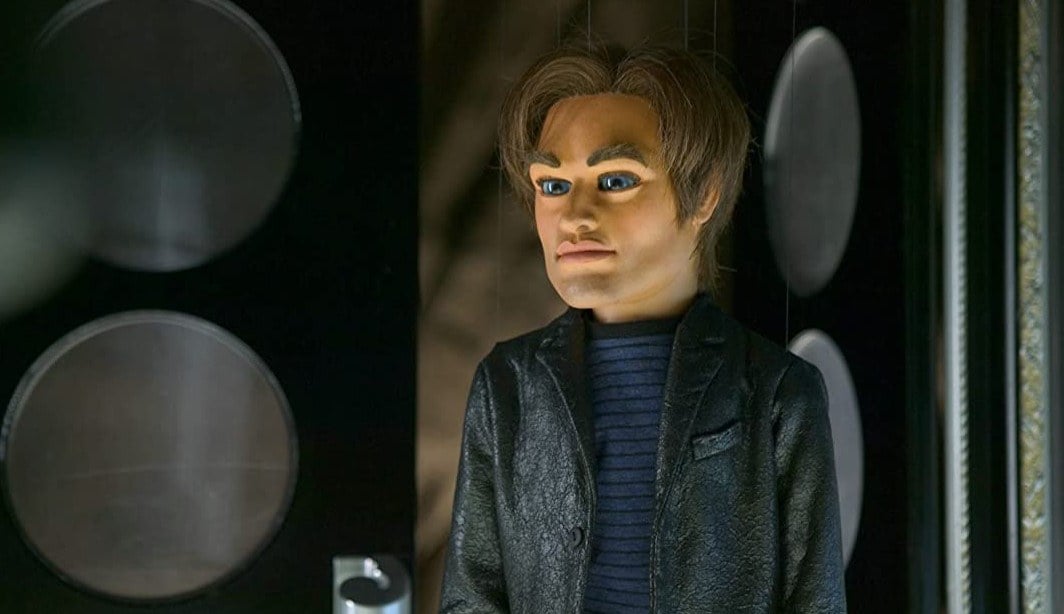
Asked if he tried to bang out footage by utilizing multiple cameras, Pope explains, “We did sometimes shoot multiple camera angles for a given setup, but because of the scale, it was hard to get a second camera in there a lot of times. Additionally, we incorporated a South Park convention in which the characters would address the camera directly; they’d be in the center of the frame and speak right to the lens. To Matt and Trey, that was very funny. So if every shot, wide and tight, has to have to puppets in the center of the frame and be able to talk right into the camera, that quickly rules out the use of a second angle.”
To guide the look of Team America, Parker and Stone gave Pope one steadfast mantra: “What would [Jerry] Bruckheimer do?” This single idea informed many of the film’s camera, lighting and narrative choices. “Doing the action genre was new to Matt and Trey,” notes Pope, “I have done action movies, but they’ve been sort of oddball ones. So doing a straightforward action film was somewhat new to us all, and whenever we had doubts about how to approach something, we’d often ask ourselves, ‘What would Bruckheimer do?’ The answer that we came up with was: when in doubt, move the camera arbitrarily. The more the average filmmaker would choose to be still for a quiet moment, the more the ‘action’ filmmaker would move the camera gratuitously. So we elected for as much gratuitous violence, action and kinetics as possible.”
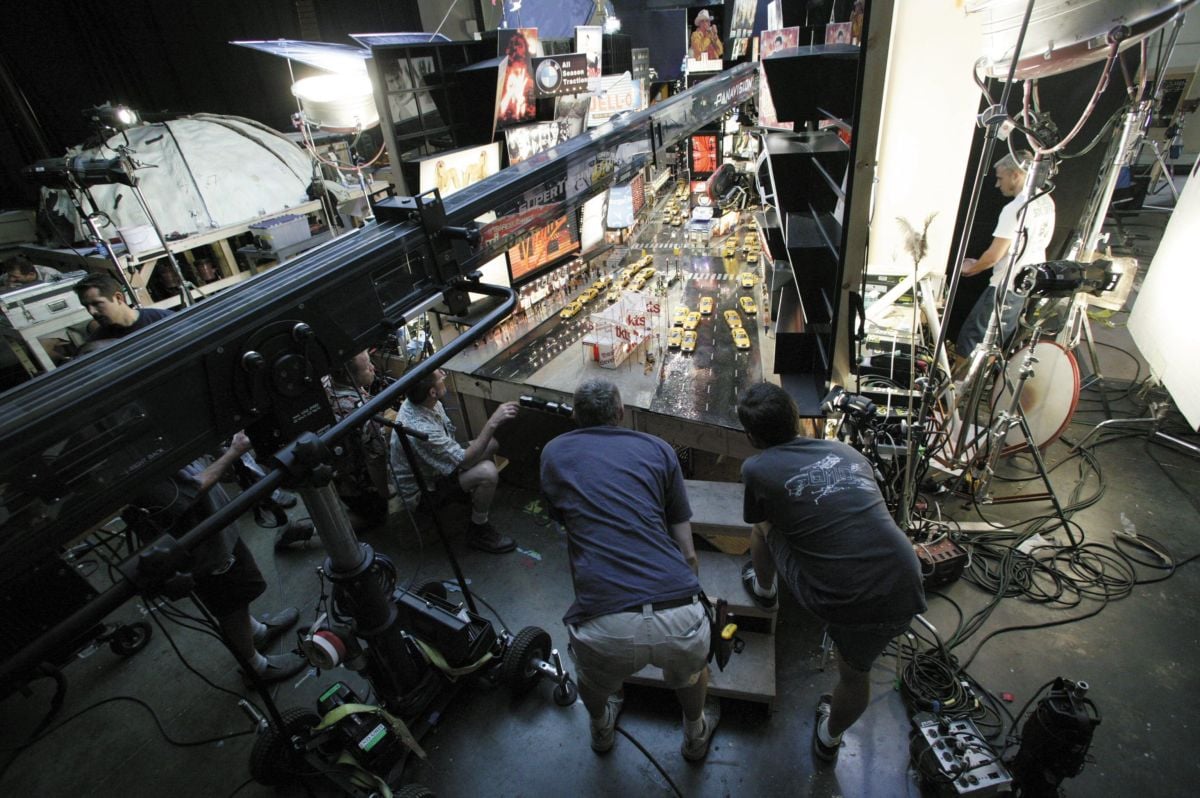
To facilitate all of the freewheeling camera movement, Pope and his crew created several custom devices to move their PanArri 435 cameras on set. “We often used a custom-made straight-shooter-type base, where we had a piece of metal with Teflon pads that fit into another piece of metal with grooves in it for it to slide on. We had a two-foot version of those made. For round moves, we tended to work off of a dolly on dance floor. My first assistant, Greg Luntzel, manufactured a bracket that holds a 435 from the top so that we didn’t have to under-sling the camera and could get the camera right down to the floor. However, we quickly came to realize was that within the world of the puppets, the crew working around them were all the equivalent of 18 feet tall and 4 feet wide, while the camera was as big as a car. It was very hard to get everybody in there to have access to the puppets. A loose hair on puppet’s wig was a major deal; we would have to pull everything out of the way to get the makeup person in there, and then bring everything back. Everything was just harder. You would think it would be easier because you just have to manipulate the puppets, but you’ve got a bunch of strings and a guy working remotely, above or below, who’s not really able to see the puppet except on a monitor. It was much more difficult to get a performance out of them.”
In addressing some of these issues, Pope worked closely with production designer Jim Dultz to help build in as much accessibility to the puppets as possible, and also to integrate architectural lighting into the set’s designs. “I spent a large part of the prep period working with Jim to figure out how we could light our small-scale sets,” Pope explains. “One of the first things I usually say to a production designer is that I much prefer a set that lights itself over a set that I have to light artificially. So we thought a lot about the lighting of the sets as he designed them. He loved being able to show off the patterns of his architecture with the built-in lighting.
“Still, we also had to work out how to leave the middle of the sets open so the puppeteers could get in there. All of the sets we built up on 4-foot tall platforms so that our puppeteers could get underneath and do rod-puppet work. For example, if we were on an exterior set, our sky backdrop was separated from the background; you could then get lights down below, which would also help light the sky. Because we were on platforms, we could always open up a section, cut a hole in a floor, and so on. If we wanted up-light on something, we could just slice a hole in the floor to accommodate the fixture.”
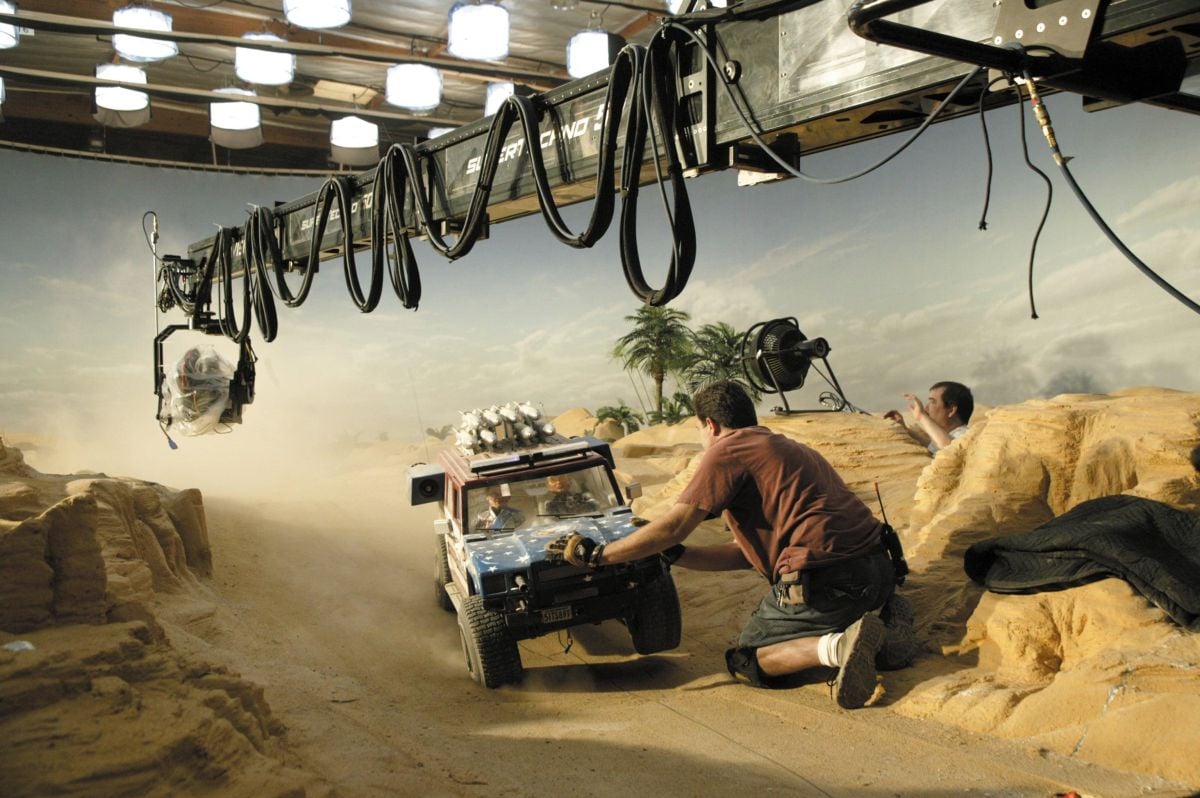
Pope confesses that the constraints the puppets imposed on the photography did challenge his initial ideas about shooting the action picture. “As much as possible, I did try to follow the conventions of the genre and learn from the action geniuses,” he submits. “They often use a lot of hard light and anamorphic lenses, but anamorphic lenses were quickly ruled out on this show because there are virtually no anamorphic macros that would allow us to work so close to the puppets. Instead, to achieve that widescreen aspect ratio, I wound up working in Super 35. Action films also tend to have dramatic lighting — backlight, bold swatches of light, smoke — but we couldn’t adopt many of those conventions because strong backlight would reveal the marionettes’ strings too much. Also, the shape of the puppets’ heads are a bit odd; they have large brow-lines and eyebrows, as well as large eyelids.
The Thunderbirds puppets were very similar. When you really look at them, their features are sort of grotesque. They’re not really built to scale, either; their heads are about one-third too large for their bodies and look sort of weird, so it was hard to light them from above and get any light in their eyes. We ended up having to put a light beneath the mattebox, so many times I had lights Velcroed under there. In that way, the look of the film sort of organically dictated itself. The content is action, and the camera movement is like what you’d see in an action film, but the lighting doesn’t follow the formal conventions of an action movie.”
To light the marionettes, the cinematographer tended to use Kino Flos. “Now, to my knowledge, that’s not an action convention, but I just couldn’t get a hard light in on the puppets. I had to work more up close and softer than most action movies would. We made up several versions of Mini Flos — two-, three-, and four-bulb units that we used to create custom softboxes. We also had Micro Flos around all of the time. They were good eyelights, and they could also be used as kick lights to pick out details on the puppets’ outfits. The mattebox was usually three feet from a puppet, so the lights could be three feet away. Our main key light was often a two-foot four-bank, and one of those placed three feet away could generate quite a lot of ‘heat’ — upwards of a T4 or a T5.6. We’d either use a two-foot bank or a four-bank placed a little farther back so that we didn’t have light dropping off in the shot. Then we’d work with the Mini Flos to wrap the lights around the puppets, creating fill light or putting a little light in their eyes.”
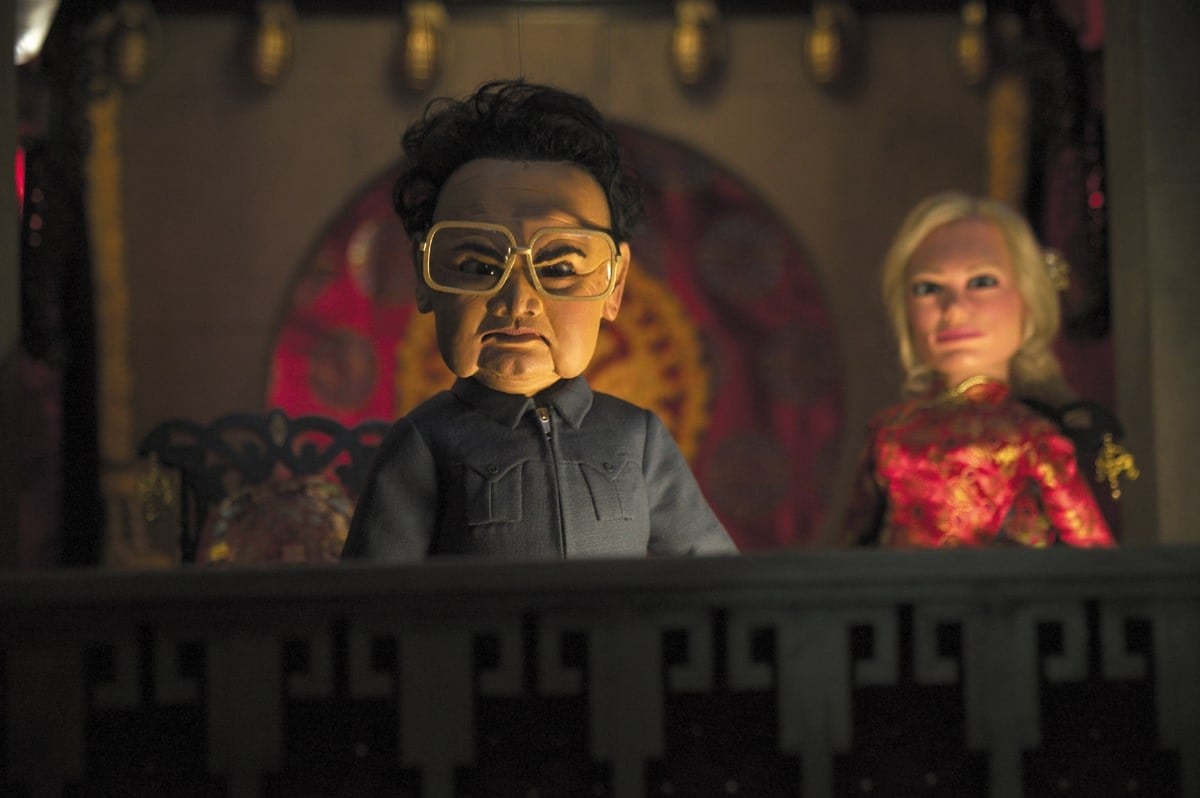
Pope photographed Team America on Kodak Vision2 500T 5218 stock, using Panavised Arri 435 cameras fitted with Primo Close-Focus Primes. He also shot the majority of the film without the benefit of printed film dailies. “We were basically dailies-free,” he admits. “We had about 10 days of film dailies, but that’s all we could afford. At the beginning of the schedule, we talked about what we really needed to see, but that was front-heavy in the schedule. We wanted to see a lot in the beginning, but once we got going we were on our own.”
Team America features many “large” set-piece sequences that unfold in scenic locations such as Paris and Egypt. Other settings include Mount Rushmore, which conceals Team America’s secret headquarters, and Kim Jong Il’s grand palace and outdoor amphitheater. “We had a big fight set in Cairo, so the production crew built the city itself and the surrounding desert, complete with pyramids,” notes Pope. “For scenes of the characters driving or flying, we constructed huge moving sky backdrops to create the illusion that our vehicles and ships were actually in motion. We put the cars on huge, belt-sander-like treadmills that were painted to look like the desert sand, and we had our various sky backgrounds whizzing by in the background as fast as possible. It was pure silent-movie, Keystone Kops technology, but it was completely ‘sellable’ within the puppet world that we were creating. We were constantly playing with different levels of realism and fakery, and it’s so complicated that I can’t even begin to articulate it. My only point of reference on what worked and what didn’t was when Matt and Trey laughed. If they laughed, I knew we’d gotten it right.”

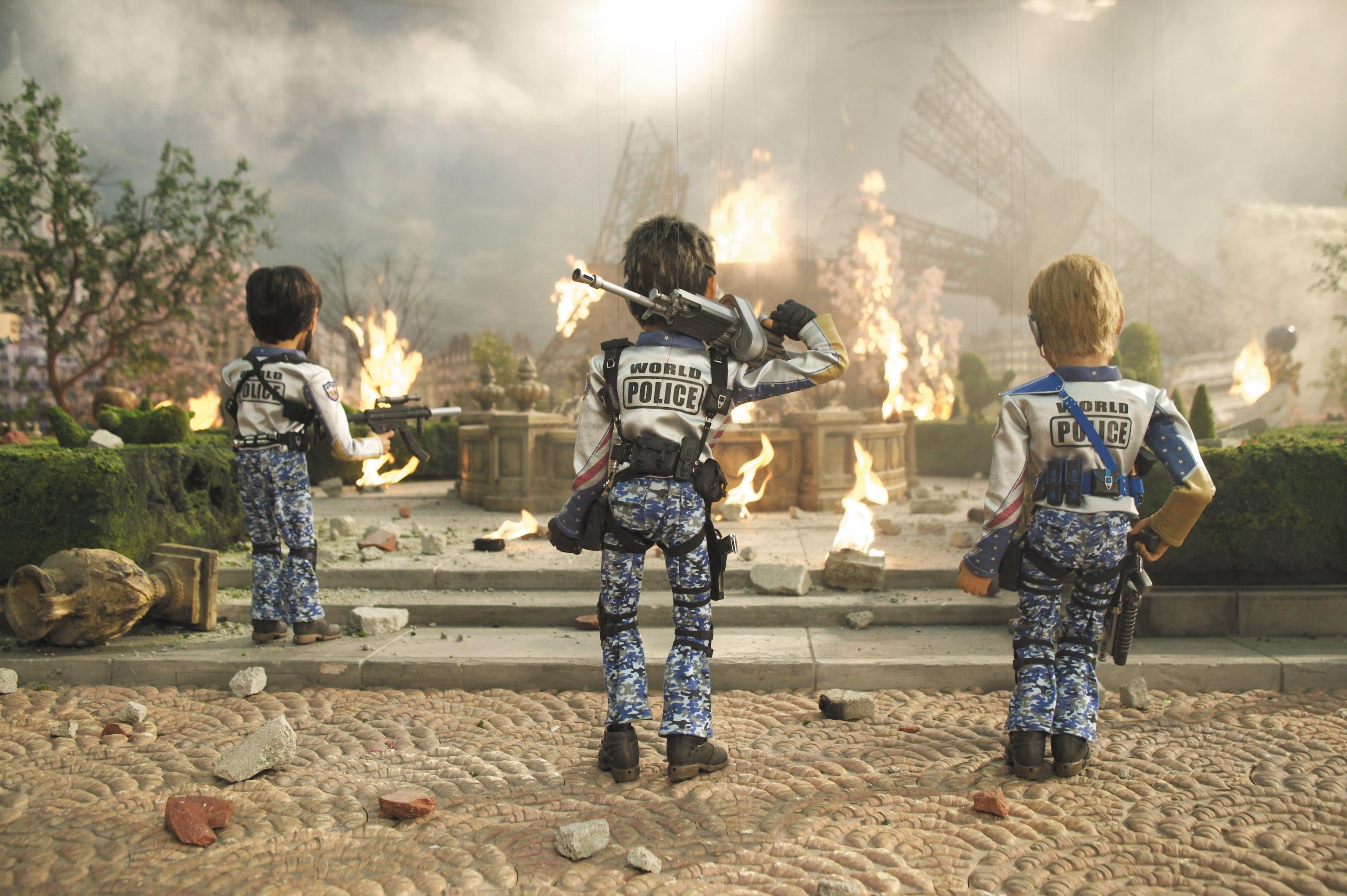
For night exterior scenes in Kim Jong Il’s amphitheater, “we put up space lights and gelled them blue to simulate a night ambience. We then used follow-spots on the stage, as well as a big disco ball and some monumental background behind the puppets — at that scale, of course, ‘monumental’ means 8-by-12 feet. Toplight was also an issue, because the puppeteers’ Condors were always in the way; we couldn’t really light from the top, other than a really soft ambience coming from underneath the Condors. Many times we had to simulate toplight by raking light down the walls, as if it was coming from the top, but then actually light the puppets from the side We didn’t want to light up the strings and we didn’t want to harshly light the puppets with their sort of Neanderthal foreheads.”
To help combat the light-sucking factor of the various Condors and puppeteer bridges built over each setup, Pope had custom Kino Flo “softboxes” affixed to the bottoms of the Condors to replace the lost ambiance that was being absorbed by the equipment and technicians. “We built the softboxes right to the base of the Condors’ buckets using Kino Flos, 216 diffusion and whatever color was applicable for a scene. We’d then just turn on as many bulbs as we needed to achieve the appropriate ambiance.”
One of the more controversial sequences in the film will surely be a highly graphic lovemaking interlude between two of the Team America characters. “That scene was hilarious, and it was the most fun for the crew in terms of sheer outlandishness,” Pope enthuses. “Of course, there’s nothing truly graphic about the scene, because the puppets are like Barbies: they don’t have any genitalia. They’re just simulating sex, and it’s totally ridiculous. We had little candles over the bed, Mount Rushmore out in the distance beyond the window and slow dolly moves with foreground elements and the sappiest music ever — all of the schmaltz. It’s a quintessential Bruckheimer moment, in that the emotion the film is trying to create is not supported by the content in any way. In a Bruckheimer movie, people will turn to each other in the middle of battle and reveal their life stories, inappropriately and unbelievably. That also happens in this film.
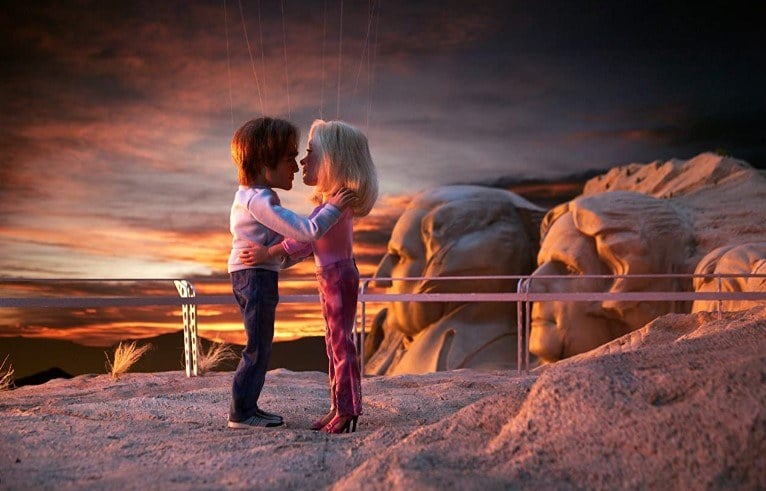
“We were screening some of our rare printed dailies the other night while the projectionist was up in the projection booth, and we were running some fairly bland footage,” Pope recalls. “Suddenly, one shot from the love scene came up and we heard this huge howl from behind the projection-booth glass. Then the projectionist’s voice came through the intercom, and he was saying, ‘I can’t wait to see this movie!’”
Stone and Parker, for their parts, feel that Team America has allowed them to cross into a whole new realm of possibilities for future projects. Concludes Stone, “On this project, cinematography and framing were the most foreign elements to us because we come from a background of low-budget films and animation. But we’re learning how important they are, especially when you’re doing a movie where you want to parody or evoke a certain type of film. Bill did a fantastic job and the film looks amazing. Team America may be a big, stupid puppet movie, but it’s great!”
Super 35mm 2.35:1
PanArri 435
Primo Close-Focus Prime Lenses
Kodak Vision 2 500T 5218
Printed on Kodak Vision 2383
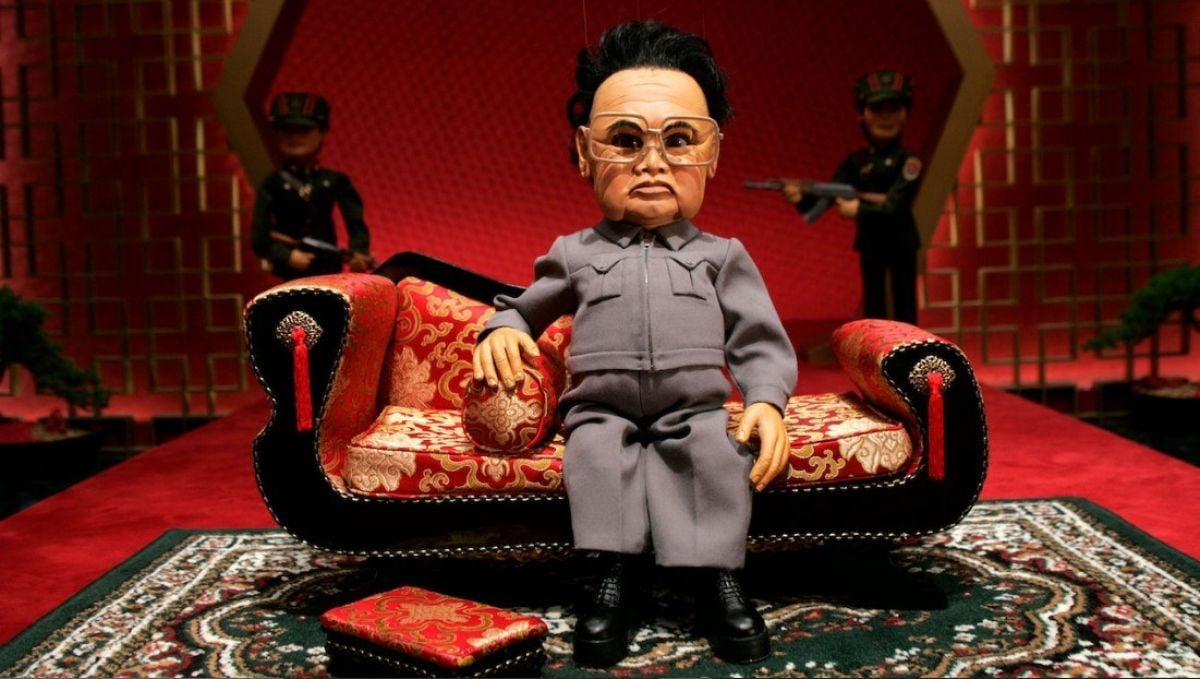
Team America posits a world war between stiff action heroes and puppet dictators. Appropriately, its stars are marionettes reminiscent of those from the ’60s Gerry Anderson Supermarionation TV series Joe 90, Captain Scarlet and Thunderbirds.
The men behind the puppets are the Chiodo Brothers: Stephen, Charlie and Edward. Over the course of their careers, they’ve employed every technique imaginable, including stop motion (Vincent, Elf), claymation (Pee Wee’s Big Adventure) and cable control (Critters) to bring inanimate objects to life. But Team America represents their greatest challenge: fabricating, mechanizing and puppeteering a huge cast of animatronic marionettes. Stephen breaks down their division of labor: “Edward did the producing, getting the puppets built for production. Charlie headed the cosmetic crew, making them look good on set. I worked with Trey [Parker], Matt [Stone] and the puppeteers to hone the performances.”
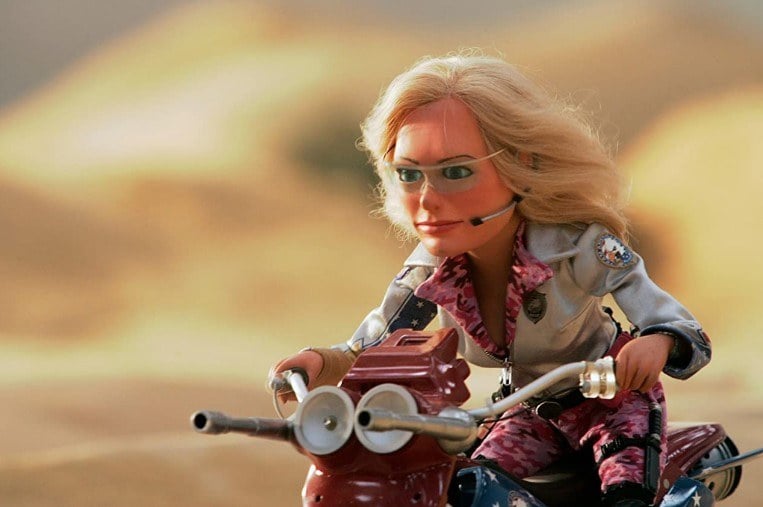
Norman Tempia designed the characters, then backwards-engineered their mechanics some 10 weeks before the Chiodos joined Team America in November 2003. Explains Charlie, “After sculpting the characters, Norman designed the underskull, which he filled with servomotors.” (Each puppet had nine servomotors that controlled eye-blinks, brow movements, jaw and lip movements, smiles and frowns.) “He made everything modular: the distance from every character’s nose to its eyes is the same. Everything plugs into its place.”
Despite the puppets’ identical internal anatomies, Tempia achieved a wide range of personalities, from the stalwart Team America characters to caricatures of Osama Bin Laden and Korean dictator Kim Jong Il.
The 22", 10-string marionettes were built to the same specs as their Gerry Anderson ancestors. “It made a lot of sense,” Edward says. “Our generic male and generic female body structures are one-third scale, which opened up a great realm of doll paraphernalia. Also, the fact that they’re puppets is part of the joke — no attempt has been made to hide their strings.”
But sometimes the joke was on the Chiodos — especially in tight shots, where there could be far more strings than characters. “When you have four puppets, the number of strings crossing faces gets way too distracting, so Trey would inevitably say, ‘Start cutting strings,’” Stephen recalls. But each severed string made the puppeteering of the marionettes harder.
The puppets’ skins were foam latex, as were their hands. As a sly homage to Thunderbirds, insert shots of gloved hands picking up objects were employed, but that’s where the resemblance ended. “They look like simple, traditional marionettes,” Stephen says, “but their radio-controlled mechanical heads really make them more like little robots on strings.”
More than 60 crewmembers constructed some 300 different characters used throughout production. “But we only made 95 hero mechanical skulls,” Stephen explains. “When we were finished with one character, Charlie’s cosmetic department would take the face off, then glue another completely different face — like little prosthetics — on the skull to create a new character. They put beards on, changed hairstyles. A night crew of six repaired and prepared the puppets for the next day’s shooting.”
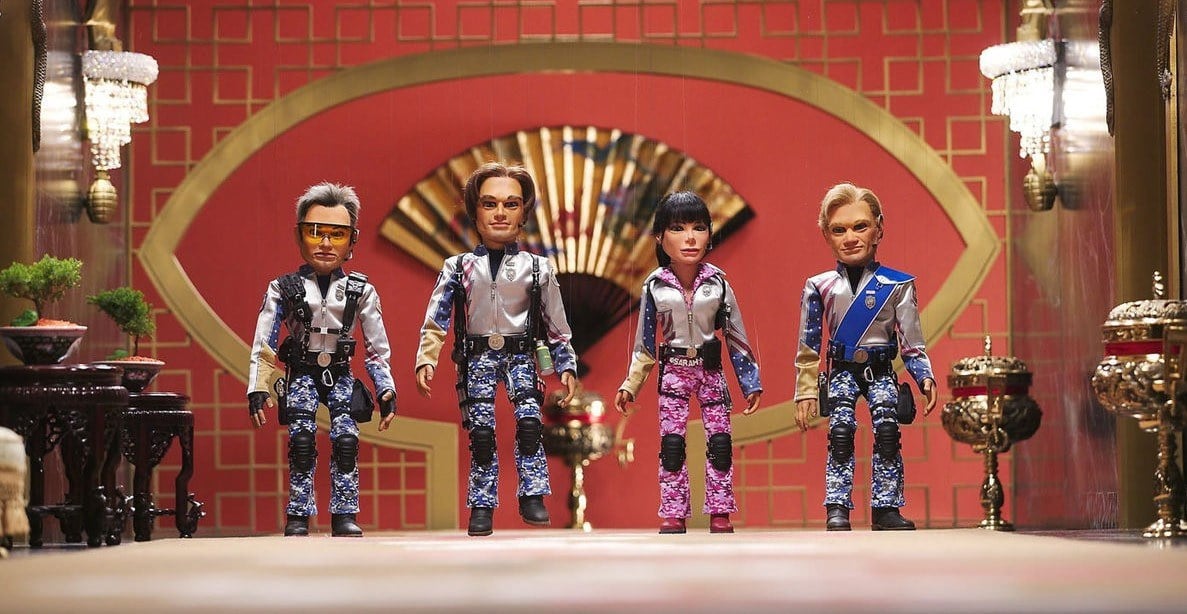
Parker and Stone rewrote the script daily to keep the satire as fresh as possible, but this created huge headaches for the Chiodos. Much like actors in musicals, puppeteers typically perform to playback. But that wasn’t possible once the rewriting began. “We started out playing prerecorded dialogue with the computerized mouths synched to the playback,” Stephen confirms. “But because Trey was rewriting, there was no time to prerecord, so he did the dialogue on the fly while other puppeteers performed the facial animation on Gilderfluke — a radio-controlled box system — along with him. Trey operated the lever that controlled the puppet’s mouth, lip-synching the dialogue loudly enough so the puppeteers doing the body movements, who were as high as 15 feet above the stage, could hear him and follow along.”
“He’s done three at a time, all having a conversation with each other,” adds Edward. “He would make the mouths open and close while the marionette-ists performed the body movements and the animatronic puppeteers made the eyes blink, the brows move, and the mouths smile and frown.”
Since this is an action movie, the puppets had their own special-effects department, headed by Oscar-winning visual-effects veteran Joe Viskocil (Independence Day), who squibbed the characters for bullet hits and more. According to Charlie, “We’ve built breakaway bodies, blow-up bodies and a variety of stunt puppets, but when it comes to the actual rigging and explosions, it’s Joe’s show.”
The Chiodos, who have stubbornly resisted effects fads, were ecstatic when Parker and Stone hired them to tackle their first marionette action picture. As Charlie concludes, “We’d always hoped people would understand the charm and audience appeal of these puppets.”
— Ron Magid
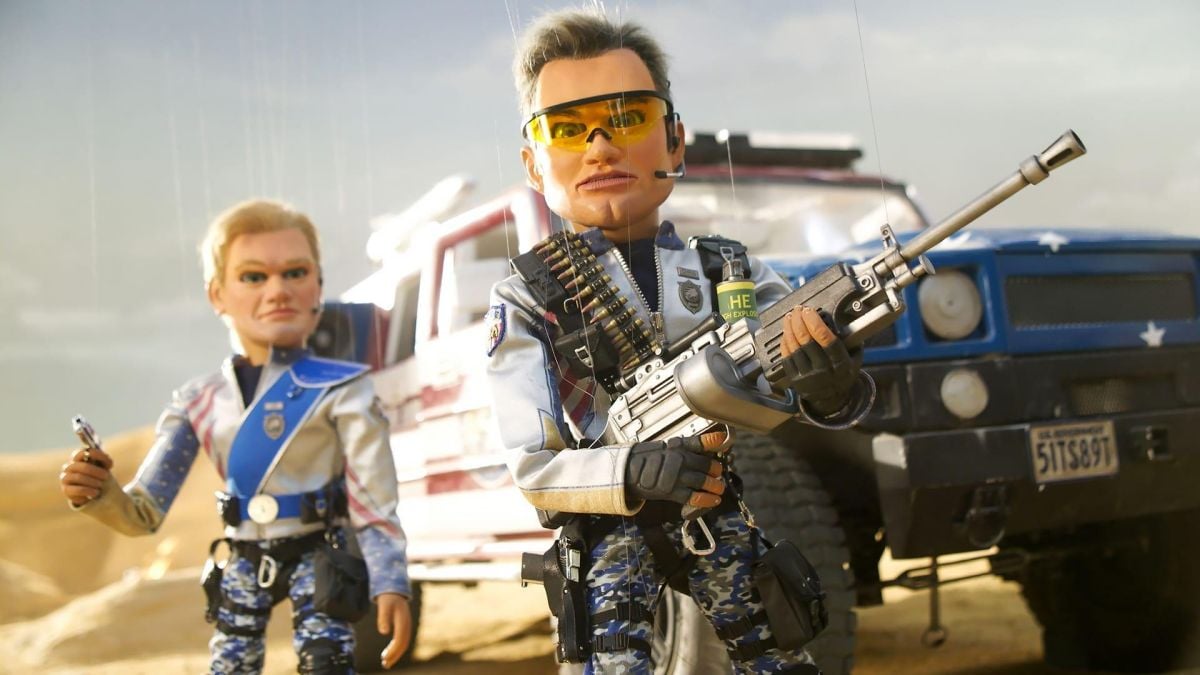
AC contributor Christopher Probst previously interviewed Pope on his work in The Matrix. Also a practicing cinematographer, Probst was later invited to join the ASC.






